#Leyte Gulf
Text
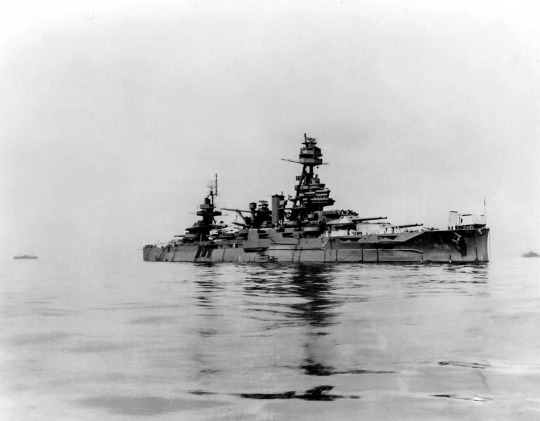
USS TEXAS (BB-35) undergoing post-operation repairs and maintenance while in San Pedro Bay, Leyte Gulf, Philippines. On her bow, a stage is set up for the road show performance of Oklahoma! for the crew's entertainment.
Date: May 17-22, 1945
Texas Parks and Wildlife Department: 2003-1012-52
#USS TEXAS (BB-35)#USS TEXAS#New York Class#battleship TEXAS#Dreadnought#Battleship#Warship#Ship#United States Navy#U.S. Navy#US Navy#USN#Navy#World War II#World War 2#WWII#WW2#WWII History#History#Military History#San Pedro Bay#Leyte Gulf#Philippines#May#1945#my post
69 notes
·
View notes
Note
What if: Japan won the Battle of Leyte Gulf?
me and a couple of friends use this AltHis for our non-historical Pacific Theatre Bolt Action games, would be interesting to hear your thoughts.
Well!
The Battle of Leyte Gulf had an extreme disparity of forces involved, so that makes me immediately go put my thinking cap on and pose the thought experiment that we would have to consider what would be realistic and attainable "Win Conditions" for the Japanese at this time.
Severe and complete incompetence, or bad planning as they did not have a unified command from what I recall, could leave the US Task Forces exposed and vulnerable, but I cannot see a total defeat of the American forces at that battle. What could however have happened is just that, a Task Force could have been isolated and ambushed if expert outmaneuvering and intelligence was implemented, and -could- have been destroyed or crippled.
So, if we can call that a "win" for Japan - which I think it can be called - in which the Japanese Imperial Navy moves about, isolates parts of the entire American force we would see present at Leyte Gulf, it would be a set-back for the Americans in the Pacific. But the Japanese ability to wage war was already hampered, and it was growing more grim by each day.
For the Pacific Theater in the context of Bolt Action games, it may mean less complete dominance of the sea and islands which leads to less confidence to perform naval invasions and the missions and operations we know today would look different - but in the grand scale it would mean that the war would just continue for a bit longer. The logical steps of the islands we saw liberated from Japan would most likely follow as they did in our time.
Barring any more critical blunders on the American side, of course.
And I want to comment that having some "AltHistory tweaking" is a great way to create a working narrative in historical war game campaigns!
6 notes
·
View notes
Text
Battle of Leyte Gulf

The Battle of Leyte Gulf was a crucial naval engagement that occurred during World War II in October 1944. It was the largest naval battle of the war, involving the combined forces of the United States and Australia against Japan. The battle took place in the waters surrounding the Philippine island of Leyte, and it played a critical role in the Allied victory in the Pacific theater.
Reasons for the Battle
One of the primary reasons for the battle was the strategic importance of the Philippines to both the Allied and Japanese forces. The Philippines had been under Japanese occupation since 1942, and the Allies were eager to retake the islands in order to establish a base from which to launch further attacks on Japan. The Japanese, meanwhile, recognized the strategic value of the Philippines and were determined to defend their position.
Another reason for the battle was the Japanese naval strategy of launching kamikaze attacks against Allied forces. Kamikaze attacks involved Japanese pilots deliberately crashing their planes into Allied ships, causing significant damage and loss of life. The Japanese hoped that these attacks would deter the Allies from continuing their offensive, and they planned to use kamikaze attacks extensively during the battle.
A third reason for the battle was the Japanese plan to divide the Allied forces by launching a decoy attack in the north while their main force attacked from the south. This strategy was intended to confuse the Allies and allow the Japanese to gain a tactical advantage.
The battle of Leyte Gulf was also fought due to the importance of the sea lanes surrounding the Philippines. The waters around the islands were key shipping routes for both the Allies and the Japanese, and control of these lanes was vital for the success of both sides.
Some say, The battle was fought because of the personal ambitions of the commanders involved. Admiral Kurita, the Japanese commander, was determined to win a major naval battle and achieve a decisive victory for Japan. Admiral Halsey, the American commander, was similarly ambitious and was eager to prove his worth as a naval commander.
Decision to Invade Philippines by Allies
A meeting between MacArthur, Nimitz, and President Roosevelt helped confirm the Philippines as a strategic target but did not reach a decision, and the debate continued for two months. Eventually Nimitz changed his mind and agreed to MacArthur's plan, and it was eventually decided that MacArthur's forces would invade the island of Leyte in the central Philippines. Amphibious forces and close naval support would be provided by Seventh Fleet, commanded by Vice Admiral Thomas C. Kinkaid.
War Structur


The battle was fought between the Japanese Imperial Navy and the Allied naval forces, which included the United States Navy's Third and Seventh Fleets, as well as the Royal Australian Navy. The Japanese fleet, under the command of Admiral Takeo Kurita, was tasked with destroying the Allied landing force at Leyte and disrupting their operations in the Philippines. The Allied forces, under the command of Admiral William Halsey and Admiral Thomas Kinkaid, were determined to protect their troops on the ground and secure the island.
Allies Strength
~300 ships in total
8 fleet carriers
9 light carriers
18 escort carriers
12 battleships
24 cruisers
116 destroyers and destroyer escorts
Many PT boats, submarines, and fleet auxiliaries
About 1,500 planes
Imperial Japan's Strength
67+ ships in total
1 fleet carrier
3 light carriers
2 hybrid-carriers/battleships
7 battleships
13 heavy cruisers
6 light cruisers
35+ destroyers
300+ planes (including land-based aircraft)
Beginning

The battle began on October 23, 1944, with a series of naval engagements between the opposing forces. The Japanese launched a surprise attack on the Allied fleet with their powerful battleships and cruisers, but the Americans were able to quickly regroup and launch a counterattack. Over the next few days, the two sides engaged in intense fighting that involved multiple naval battles and air strikes.
Significant Events
Musashi

Musashi under aerial bombardment
One of the key moments in the battle came on October 25, when the Japanese attempted to penetrate the Leyte Gulf with their battleships. However, the Allied forces were prepared for this maneuver and were able to sink several of the Japanese ships, including the battleship Musashi, one of the largest and most powerful warships ever built. The loss of the Musashi dealt a significant blow to the Japanese fleet and boosted the morale of the Allied forces.
Sinking of Fusō
The traditional account of the sinking of Fusō was that she exploded into two halves that remained floating for some time. However, Fusō survivor Hideo Ogawa, interrogated in 1945, in an article on the battleship's last voyage, stated: "Shortly after 0400 the ship capsized slowly to starboard and Ogawa and others were washed away," without specifically mentioning the bisection. Fusō was hit on the starboard side by two or possibly three torpedoes. One of these started an oil fire, and as the fuel used by IJN ships was poorly refined and easily ignited, burning patches of fuel could have led to the description from Allied observers of Fusō "blowing up". However, battleships were known sometimes to be cut into two or even three sections which could remain afloat independently, and Samuel Morison states that the bow half of Fusō was sunk by gunfire from Louisville, and the stern half sank off Kanihaan Island.
First kamikaze attacks of the Pacific War
The first kamikaze attacks of the Pacific War occurred on October 25, 1944, during the Battle of Leyte Gulf. The attacks were carried out by Japanese pilots who deliberately crashed their planes into Allied ships, causing significant damage and loss of life. The kamikaze attacks represented a new tactic in the war, and they would go on to have a significant impact on the course of the conflict.
The idea of kamikaze attacks originated in Japan in the months leading up to the Battle of Leyte Gulf. The Japanese military was facing a dire situation, with their forces in the Pacific stretched thin and the Allies gaining momentum. The Japanese were looking for new tactics to use in the fight against the Allies, and they began to consider the use of suicide attacks.
The first kamikaze attacks were carried out by a group of Japanese pilots who had been specially trained for the task. The pilots flew their planes directly into Allied ships, causing massive explosions and fires. The first attack was on a escort carrier named Santee. The attack killed 16 crewmen. Even though emergency repairs saved Santee from sinking. The second attack was on escort carrier named Suwannee which killed 71 crewmen. Suwannee was hit by another kamikaze around noon on 26 October that caused even more damage and killed 36 more crewmen. This second kamikaze strike caused a large fire that was not extinguished until nine hours later. A total of 107 sailors were killed and over 150 were wounded on Suwannee in the kamikaze attacks on 25–26 October. 5 Avenger torpedo bombers and 9 Hellcat fighters on Suwannee were destroyed.
The attacks were highly effective, and the Allies were caught off guard by the new tactic. The kamikaze attacks caused significant damage to the Allied fleet, sinking or damaging several ships. The kamikaze attacks were highly controversial, even within Japan. Many Japanese military leaders opposed the tactic, believing that it was wasteful and dishonorable. However, others saw it as a necessary measure to turn the tide of the war. Despite the controversy, the kamikaze attacks would go on to become a staple of Japanese military strategy in the Pacific War. The attacks were highly effective, and they caused significant damage to Allied forces. The kamikaze pilots were revered in Japan as heroes, and their sacrifice was seen as a necessary measure to defend the homeland. The kamikaze attacks also had a significant psychological impact on the Allied forces. The pilots were willing to give up their lives for their cause, and this willingness to die for their country was something that the Allies found difficult to understand. The attacks created a sense of fear and dread among Allied troops, as they knew that they could be targeted by kamikaze pilots at any time.
End
Despite this setback, the Japanese continued to fight fiercely, and the battle raged on for several more days. In the end, the Allied forces emerged victorious, having successfully repelled the Japanese attack and secured their position on the island of Leyte. The battle was a decisive moment in the war in the Pacific, as it effectively ended Japan's naval supremacy and paved the way for the eventual Allied victory.
The Battle of Leyte Gulf was a complex and highly strategic engagement that involved multiple naval tactics and maneuvers. It demonstrated the importance of air power in naval warfare, as both sides heavily relied on their aircraft carriers and fighter planes to gain an advantage. The battle also showcased the bravery and skill of the sailors and pilots involved, many of whom made significant sacrifices to ensure victory for their respective sides. Today, the Battle of Leyte Gulf is remembered as one of the most significant naval battles in history. It played a crucial role in the Allied victory in the Pacific and helped to shape the course of World War II. Its legacy continues to be felt to this day, as the lessons learned from the battle continue to inform modern naval strategy and tactics.
#Battle of leyte gulf#Leyte Gulf#Naval#Navy#Battle#Largest#Japanese#Imperial#America#Allies#Axis#Australia#Musashi#World War#2#Greatest
1 note
·
View note
Text

A water plume from a torpedo striking against the bow of super-battleship Musashi rises high in the air during the Battle of the Sibuyan Sea, 24 Oct 1944
44 notes
·
View notes
Text
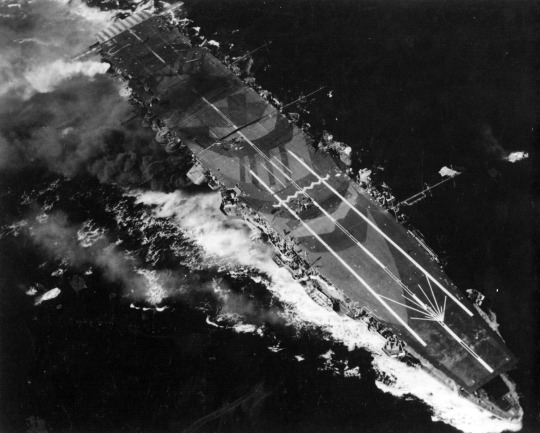
Porte-avions japonais Zuiho attaqué par des avions de l'USS Enterprise pendant la bataille du Cap Engano – Bataille du golfe de Leyte – Campagne des Philippines (1944-1945) – Guerre du Pacifique – Luçon – Philippines – 25 octobre 1944
#WWII#guerre du pacifique#pacific war#campagne des philippines (44-45)#philippines campaign (44-45)#bataille du golfe de leyte#battle of leyte gulf#bataille du cap engano#battle off cape engano#marine impériale japonaise#imperial japanese navy#ijn#porte-avions#aircraft carrier#classe zuiho#zuiho-class#zuiho#cap engano#cape engano#luçon#luzon#philippines#25/10/1944#10/1944#1944
19 notes
·
View notes
Text
youtube
#youtube#militarytraining#USS Leyte Gulf Homecoming#Final Deployment#USS Leyte Gulf#Military#USS Leyte Gulf Deployment#Family Reunion#Navy#US Navy#Homecoming#Deployment#Navy Deployment#Navy Homecoming#Emotional Reunion#US Navy Homecoming#Emotional Navy Homecoming#Military Homecoming#Military Family Reunion#Emotional Homecoming#Military Reunion#Emotional Military Homecoming
0 notes
Text
During the Battle of Leyte Gulf, the Japanese Utilize Kamikaze (“divine wind”) Airplanes Against American Warships for the First Time. It will Prove Disastrous – to Both Sides. October 25, 1944.
Image: St. Lo exploding after a kamikaze strike. (Public Domain)
On this day in history, October 25, 1944, during the Battle of Leyte Gulf, the Japanese utilize Kamikaze (“divine wind”) airplanes against American warships for the first time. It will prove disastrous – to both sides.
This decision to engage suicide bombers against the American ships at Leyte, an island of the Philippines, was…

View On WordPress
1 note
·
View note
Text

© Paolo Dala
Scenes That Elevate The Mind
What are the scenes of nature that elevate the mind and produce the sublime sensation… the hoary mountain, the solitary lake,
the aged forest and torrent falling over rocks.
Hugh Blair
Lecture Notes from 1783
#Hugh Blair#Lecture Notes from 1783#Water#Ocean#Beach#Sea#Nature#Black and White#Gulf of Leyte#Guiuan#Eastern Samar#Philippines
0 notes
Text
Remembering the Battle of Leyte Gulf: October 1944.

The largest naval battle in history, the Battle of Leyte Gulf off the coast of the Philippines, was another step in the U.S. advance toward the Japanese home islands. All available Japanese forces were thrown into the area, but the separate units failed to unite, resulting in several actions scattered over a wide area.
All four Japanese light carriers were sunk, as were three battleships. Leyte Gulf also marked the first use of a desperate new tactic: the escort carrier USS St. Louis was sunk after a Japanese kamikaze carrying a bomb deliberately crashed on its deck.
[More Here: Are Light Carriers Poised to Make a Comeback?]
#u.s. forces#japanese force#Battle of Leyte Gulf#military soldiers#battleships#USS St. Louis#naval ships#naval battle#year 1944#chronology
0 notes
Text
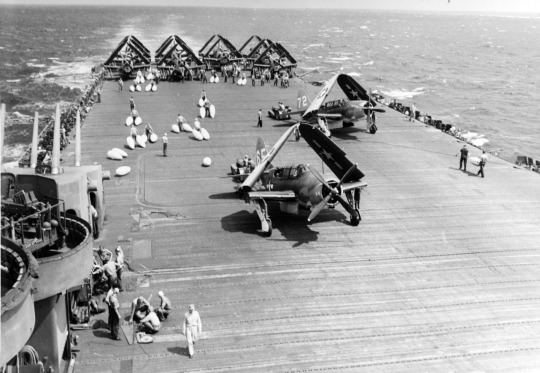
Loading drop tanks on Curtiss SB2C Helldivers aboard USS LEXINGTON (CV-16) before a search mission.
Date: October 25, 1944
U.S. Naval History and Heritage Command: 80-G-284381
#USS Lexington (CV-16)#USS Lexington#Essex Class#Aircraft Carrier#Carrier#Warship#Ship#United States Navy#U.S. Navy#US Navy#USN#Navy#World War II#World War 2#WWII#WW2#WWII History#History#Military History#Battle of the Sibuyan Sea#Battle of Leyte Gulf#Tablas Strait#Philippines#Philippines campaign#Pacific Theater#October#1944#Curtiss SB2C Helldiver#Dive bomber#my post
85 notes
·
View notes
Text

USS Leyte Gulf (CG-55) is a Ticonderoga-class guided-missile cruiser in the United States Navy. It has a displacement of approximately 9,600 tons, measures 567 feet (173 meters) in length, 55 feet (16.8 meters) in beam, and has a draft of 34 feet (10.2 meters). Powered by four General Electric LM2500 gas turbine engines, it achieves speeds over 30 knots and has an unlimited range due to its capability for underway replenishment. The crew consists of 33 officers and 327 enlisted personnel. Armament includes two Mk 41 Vertical Launch Systems, two Mk 45 5-inch guns, two Mk 38 25 mm guns, eight Harpoon missile launchers, two Phalanx CIWS, and various machine guns. The ship also supports two SH-60 Seahawk helicopters. Built by Ingalls Shipbuilding, it was commissioned on September 26, 1987. The USS Leyte Gulf has been involved in numerous deployments and operations, showcasing its versatility and importance in modern naval operations.
21 notes
·
View notes
Text

Philippines study time! First one is from a photo in Leyte Gulf, 1944
32 notes
·
View notes
Text

Explosion on USS St. Lo (CVE-63) after being hit by a kamikaze aircraft during the Battle off Samar, 25 October 1944
14 notes
·
View notes
Text
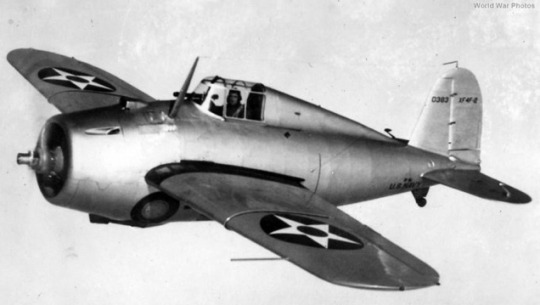
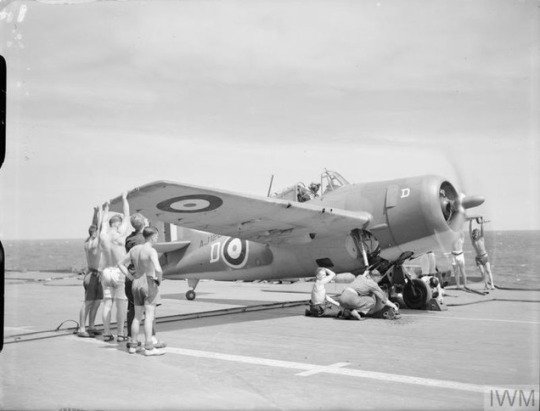
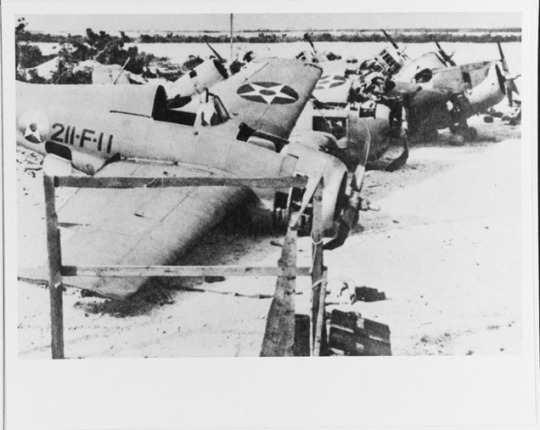
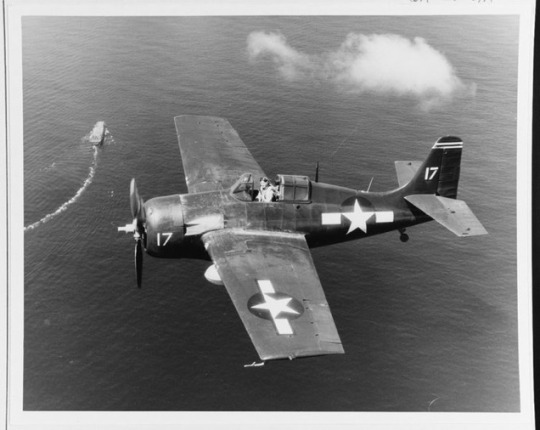
2nd September 1937. First flight of the Grumman XF4F fighter, which would become known as the Wildcat. Its performance was initially inferior to the rival Brewster Buffalo, and the aircraft required an extensive redesign before being put into production. Despite this unpromising beginning, the Wildcat would prove crucial in the early stages of the Pacific war. Though less manoeuvrable than the Japanese Zero, it was well armed, rugged and a capable adversary in the hands of a skilled pilot.
The Wildcat’s first combat sorties were actually flown by the Royal Navy’s Fleet Air Arm. Named Martlet in British use until 1944, the type’s first victory was a Junkers 88 over Scapa Flow on Christmas Day 1940. Martlets went on to serve successfully on the first Royal Navy escort carrier, HMS Audacity, in 1941. They continued in this role until the end of the war, scoring their final victories in Fleet Air Arm service by shooting down four Bf 109s in March 1945.
Wildcats first flew in combat against the Japanese during the attempt to take Wake Island in early December 1941. Four Marine F4Fs mounted a heroic defence, breaking up several air attacks as well as sinking a destroyer and submarine with 100lb bombs before the island finally fell on 23rd December. Wildcats served in all the key early engagements of the Pacific war, including Coral Sea, Midway and the defence of Guadalcanal.
Wildcats quickly established a reputation for toughness, able to absorb far more punishment than their Japanese opponents, and had an impressive kill/loss ratio. Wildcats were credited with destroying over 1,000 Japanese aircraft for 178 aerial losses, 24 to anti-aircraft fire, and 49 to operational causes. One Navy and seven Marine Corps pilots would earn the Medal of Honor in Wildcats.
In early 1943, Wildcat production was taken over by General Motors under the designation FM-1 and later the improved FM-2. Though replaced by the more powerful Hellcat on American fleet carriers during that year, the Wildcat’s small size and light weight made it ideal for use on escort and light carriers. With the addition of folding wings, they were well suited to the limited hangar and deck space available.
As in Royal Naval service, they remained in use until the end of the war. For example, during the battle of Leyte Gulf in October 1944, Wildcats mounted strafing runs against Japanese warships, helping to buy time for their parent escort carriers to escape.
Pictured:
1) First prototype Grumman XF4F-2 in flight. Note the cowling machine guns, forward radio antenna mast and telescopic gunsight, none of which featured on production models.
📷 thisdayinaviation.com
2) Grumman Martlet of 888 Squadron NAS warming up on board HMS Formidable prior to takeoff.
📷 IWM (A 11640)
3) Wrecked Grumman F4F-3 Wildcat fighters of Marine Fighting Squadron 211 (VMF-211), photographed by by the Wake airstrip sometime after the Japanese captured the island on 23rd December 1941. The plane in the foreground, 211-F-11, was flown by Captain Henry T. Elrod during the 11th December attacks that sank the Japanese destroyer Kisaragi. Damaged beyond repair at that time, 211-F-11 was subsequently used as a source of parts to keep other planes operational. Elrod received a posthumous Medal of Honor after leading a beach defence unit during the final Japanese assault.
📷 NHHC 80-G-179006
4) FM-2 Wildcat over the escort carrier USS Santee during the Leyte landings on 20th October. Santee would survive a kamikaze attack and a torpedo hit from a Japanese submarine 5 days later.
📷 NHHC 80-G-287594
@JamieMctrusty via X
#wildcat#martlet#grumman aviation#Goodyear aviation#navy#aircraft#fighter#aviation#us navy#carrier aviation#ww2
12 notes
·
View notes
Note
Smutfest
Daggers - Hannix
“I want you to ruin me.”
Ripping clothing/breeding 👀
I really loved all of these Hannix asks! I combined a few of them....


Written for my Smutsational Smutfest!
This Is Becoming a Routine
It had become a routine. If you did something enough times, it became a habit. And Nat had been doing Jake for weeks, since the start of their deployment together on the USS Leyte Gulf.
Nat watched Jake as he sat at the foot of her bed with his cock in his hand, stroking himself.
"Please, Bagman," she whined, "I want you to ruin me!"
But he just shook his head and pushed her gently back down whenever she tried to get up. "No, lie back and touch yourself." And she did, because he knew she was addicted to pleasing him in bed. "Two fingers in your pussy. That's right. Spread your legs wider." The way she was touching herself was mesmerizing as she moaned and bit her lip
Before she could beg for his touch, he was on her, ripping her bra in his haste to remove it. "Hey! I said ruin me, not my clothing," she complained, but his mouth was on her tits, and he was pulling her fingers out of her pussy.
"Don't be sassy," he drawled, licking her fingers while she whined.
"Don't tell me what to do, Bagman," she replied, but he let her know with his lips on hers that he meant business.
Nearly an hour later, Nat was practically keening as Jake whispered, "I want to have my way with you." But he wouldn't let her come.
"Please?" she begged as his fingers gently circled her clit. He held her down with his other hand so she couldn't yet get the pressure she wanted.
"You know what I want you to say," he scolded.
"Please, Bagman?" she moaned, but he shook his head, keeping her just an inch from her orgasm. Nat was panting, finally caving and saying the one thing he was dying to hear her say. "Please, Jake?"
He groaned in pleasure at the sound of his name on her lips, guiding his cock inside her and fucking her with five good strokes before she was squeezing him and crying out, "Jake!"
"Good girl," he praised, chasing his own release. He filled her up with his cum and continued fucking it deep inside her until she was shaking with relief.
He only had a few more weeks to get her to admit she loved him.
66 notes
·
View notes
Text

This Day in History: Richard O'Kane, WWII Hero
On this day in 1946, a hero receives the Medal of Honor. Richard O’Kane has been called “America’s undersea ace of aces.” He was a legend of World War II and commander of USS Tang. During that submarine’s five war patrols, O’Kane is officially credited with sinking 24 enemy ships.
He believed 33 to be a more accurate number.
Tang’s final engagement came during the Battle of Leyte Gulf, near the Philippines. Tang’s crew was then scanning nearby waters for enemy activity. Late on October 23, 1944, a convoy of about 10 enemy ships was spotted near the Taiwan Strait.
The story continues here: https://www.taraross.com/post/tdih-richard-okane-moh
#tdih#otd#this day in history#world war ii#history#history blog#America#US navy#medal of honor#sharethehistory
10 notes
·
View notes